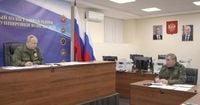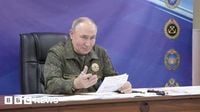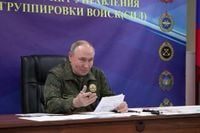Russia has once again thrust itself into the global spotlight by announcing the successful test of a new nuclear-powered, nuclear-capable cruise missile, the Burevestnik, a weapon that both excites and alarms the world’s military analysts. In remarks released on Sunday, October 26, 2025, President Vladimir Putin confirmed the milestone, describing the missile as a "unique creation that no one else in the world possesses," according to a Kremlin video cited by BBC and Reuters. The test, which took place on October 21, 2025, marks the latest chapter in a years-long saga of development, setbacks, and international scrutiny surrounding a weapon NATO has code-named "Skyfall."
General Valery Gerasimov, Russia’s chief of general staff, briefed Putin at a command post, as shown in footage released by the Kremlin. Gerasimov reported that the Burevestnik covered an astonishing 14,000 kilometers (8,700 miles) during a 15-hour flight, powered by a nuclear engine. He emphasized, "that's not the limit," suggesting the missile’s range could be even greater. According to Russia’s Tass news agency, the missile’s vertical and horizontal maneuvering were tested and found to be up to specification, demonstrating high capabilities to bypass missile and air defense systems.
The Burevestnik, first unveiled by Putin in his 2018 state-of-the-nation address, has been touted as a potentially game-changing weapon because of its supposed "unlimited range" and unpredictable flight path. The missile, which can reportedly fly as low as 50 to 100 meters above ground, is designed to evade existing and even future missile defense systems. "We need to determine the possible uses and begin preparing the infrastructure for deploying these weapons to our armed forces," Putin told Gerasimov, signaling a clear intent to move toward operational deployment.
Yet, the Burevestnik’s journey has not been smooth. Western experts have long expressed skepticism about the missile’s reliability and safety, particularly given the risks of a nuclear-powered engine. As the International Institute for Strategic Studies (IISS) noted in 2021, "Its entry into Russia's inventory arguably hinges not only on overcoming the considerable technical challenge of ensuring the reliable performance of the nuclear-propulsion unit," but also on addressing the environmental and safety hazards posed by such a system. The missile’s troubled history includes a tragic incident in August 2019, when an explosion during testing at a navy range on the White Sea killed five nuclear engineers and two service members, causing a brief spike in radioactivity in a nearby city. While Russian officials did not publicly identify the weapon involved, U.S. sources told Reuters it was the Burevestnik.
Despite these setbacks, the Kremlin has pressed forward. A 2024 satellite analysis cited by Reuters identified a facility 475 kilometers north of Moscow as the likely launch site for the Burevestnik, with nine horizontal launch pads under construction. The missile is thought to be powered by a nuclear reactor that activates after solid fuel rocket boosters launch it, a design reminiscent of ambitious but ultimately abandoned U.S. and Soviet projects from the Cold War era.
According to the U.S. Air Force's National Air and Space Intelligence Center, "A nuclear-powered cruise missile would give Russia a unique weapon with intercontinental range capability." A Russian military journal, quoted by the IISS, claims the missile could be based anywhere in Russia and still reach targets in the continental United States. However, Western analysts remain divided on whether the Burevestnik offers Russia any real strategic advantage over its existing arsenal of intercontinental ballistic missiles (ICBMs) and submarine-launched ballistic missiles (SLBMs). Some suggest the weapon is more about psychological impact and nuclear messaging than battlefield utility.
Putin’s announcement of the successful test came just days after he personally oversaw large-scale drills of Russia’s strategic nuclear forces on October 22, 2025. These exercises, which involved practice launches of ICBMs from northwestern Russia and a submarine in the Barents Sea, as well as Tu-95 strategic bombers firing long-range cruise missiles, were meant to test the readiness and command systems of the Russian military. "The modernity of our nuclear deterrent forces is at the highest level," Putin declared, underscoring the Kremlin’s emphasis on nuclear capabilities at a time of heightened tensions with the West. Notably, NATO was wrapping up its own nuclear exercises over the North Sea at the same time, highlighting the ongoing standoff between Russia and Western military alliances.
The Burevestnik’s capabilities and Russia’s willingness to showcase them are widely seen as part of a broader campaign of nuclear signaling. The Kremlin has repeatedly warned the U.S. and other NATO allies against sanctioning strikes deep inside Russia with longer-range Western weapons, and has resisted Western pressure for a ceasefire in Ukraine. In the context of Russia’s ongoing war in Ukraine, the missile’s development serves as a reminder of Moscow’s determination to maintain strategic parity—or even superiority—with the United States and its allies.
Still, questions linger about the Burevestnik’s true effectiveness and the wisdom of deploying such a weapon. Of at least 13 known tests since 2016, only two had partial success, according to an arms control campaign group cited by BBC. Putin claimed a "final successful test" had taken place in 2023, but this assertion could not be independently verified. As for the latest test, while Russian officials have trumpeted its success, many Western observers remain cautious, noting the lack of independent confirmation and the technical hurdles that remain.
Kirill Dmitriev, a top Putin aide who was in the U.S. as the video surfaced, said his delegation had informed U.S. colleagues of the "successful testing" of the Burevestnik, calling it an "absolutely new class" of weapon. Meanwhile, the International Institute for Strategic Studies and other analysts continue to debate whether the missile’s development is a genuine leap forward or a costly and dangerous gamble.
As the world digests the implications of Russia’s latest technological feat, one thing is clear: the Burevestnik missile, for all its promise and peril, has reignited debates about the future of nuclear deterrence, arms control, and the risks of a new era of superpower competition. Whether the weapon will ultimately change the strategic balance or remain a symbol of Russia’s nuclear ambitions is a question only time—and further tests—will answer.






